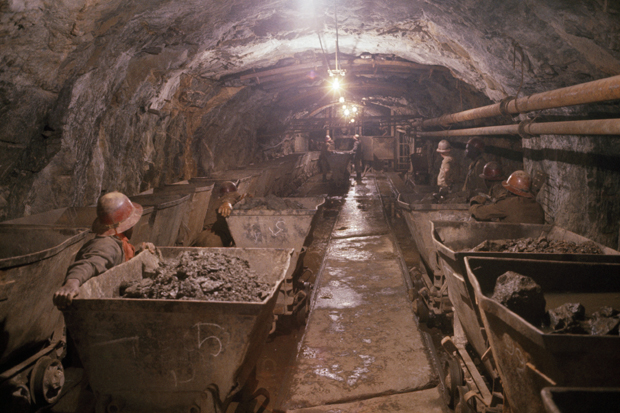A teenager in the second decade of the Cold War, my father was taught to play snooker by a KGB agent. His own father was the principal of a theological college in London that had been allowed to accept two foreign students from Russia only if, said the Moscow authorities, a third ‘student’ (notably less ardent in his desire to become a clergyman) was allowed to accompany them.
And this is the problem of the world of international espionage: you think it’s going to be all poisoned-tip umbrellas and canasta parties but can wind up in South Norwood studying early church history while making sure Sergey and Dmitry aren’t getting the bus up to Whitehall in the afternoons or swapping briefcases with carnation-wearing strangers at train stations. After writing your daily dispatch in lemon juice with a cocktail stick, you end up with nothing more exciting to do with your evening than play my dad at snooker.
Spies in the Congo drives home how trying the cover-life of a spy can be, introducing us to American agents who played a potentially civilisation-saving role during the second world war by posing as businessmen, photographers, ornithologists and gem prospectors in the Belgian Congo. Frequently ill with malaria and other afflictions, and faced with track and river journeys that would make even a Southern Rail commuter shudder, these spooks, in the present-day Democratic Republic of Congo, gave service to the Allied forces that was tough and, until now, largely thankless.
The US agents’ central task was to prevent the Germans from acquiring high-grade uranium that could be used by the Nazis to make a nuclear bomb. For the Congo, in particular its Katanga region nestled in the east, was — and indeed remains, as eagle-eyed perusers of the Snowden documents may notice — the source of the richest uranium in the world. A mine called Shinkolobwe yielded uranium ore with as high as 75 per cent uranium oxide and an average of 65 per cent, levels that were extraordinary compared with mines in Canada, which gave up ores of just 0.02 per cent uranium oxide, or South African ores that came in at 0.03 per cent. From 1940, the Americans began to ship from the Congo to New York several thousand tonnes of this super-rich ore, at the time key to separating out the rare fissionable uranium or making bomb-grade plutonium.
Relying in large part on papers that have only recently been made public, Susan Williams lays out in fascinating detail how several score US spies went about monitoring whether the Germans were gathering Congolese uranium and preparing to scupper them if so. The bind, though, was that (in a manner reminiscent of Spielberg’s Raiders of the Lost Ark, where the Nazis are likewise in quest of a potent source of catastrophic power) the agents couldn’t be seen to be taking any interest in uranium whatsoever, for at the time the bare idea of a uranium-led project to create a bomb was quite unknown. Because there was every chance the Germans would realise that US spooks were circulating in the region — a possibility made more likely by Belgium itself having fallen to the Nazis — the Americans cloaked their operations under the veil of an apparent mission to seek control of the Congo’s diamond trade. Industrial diamonds were openly needed by both sides for their war efforts, but they were small fry compared with occult nuclear materials, and so their control was used as plausible cover for the uranium investigation and oversight.
The result was multiple layers of secrecy, like skins of an onion, and Williams’s account is nuanced but gripping. There was unease and distrust between America’s spy agency, the Office of Strategic Services, and its diplomatic bodies in the Belgian Congo and (plus ça change) we learn that US and British intelligence went together like oil and water. Belgium’s Société Générale and Union Minière (relabelled Umicore in 2001) proved tainted by Nazi influence, and there were dramatic scenes when one of the key US agents was betrayed by domestic authorities and forced to flee the country after attempts were made on his life.
Meanwhile, back in the US, some 130,000 workers (the population of non-metropolitan Norwich, as Alan Partridge would note) were busy on the Manhattan Project, readying the bomb, an endeavour fully understood by only a tiny number of those taking part in it. At every level we see key operatives making vital contributions to they knew not what.
Williams does a sterling job of delineating a complicated plot while at the same time giving a clear sense of the characters of the major players. Wilbur ‘Dock’ Hogue, codenamed TETON or WEST, was the Léopoldville head of station who had the nerve of a James Bond but none of the frippery. And we meet a large cast of other brave but unassuming agents, including LOCUST, who moved around the country under cover of an interest in silk textiles; CLOCK, who operated under the cloak of the Texas Oil Company; RUFUS, who flew below the radar with Pan Am; and the plucky agent and administrator ANGELLA. Gorilla-collectors and ornithologists were also in tow, sometimes more particular about wildlife taxonomy than properly encoding transmissions, to the chagrin of their bosses.
The exploits of these men and women are only now emerging from the archives. While the threat of Hitler getting his hands on a nuclear bomb proved empty, they are owed belated awareness and thanks for staving off great potential horror.
The understated stoics that populate Williams’s story were rather different to the secret agents that Giles Milton writes about in his latest book: a fresh account of the men behind Britain’s Special Operations Executive, the unit created by Churchill to carry out espionage and sabotage in Occupied Europe. Flashier than Williams’s crew, these operatives were behind many audacious and spectacular operations, including the 1943 destruction of the Norsk Hydro Plant in Norway, which was being used to manufacture heavy water for the Nazis’ atomic bomb programme.
Many of the subjects of Milton’s book have been well covered before, whether it be Operation Anthropoid, the SOE-planned assassination of key Nazi henchman Reynard Heydrich by two Czechoslovaks in 1942, or the same year’s Operation Harling, in which the Gorgopotamos viaduct in Greece was destroyed, boosting Allied morale although its objective of stanching supplies for Rommel’s troops had been made redundant by the Allied victory at El Alamein.
What sets Milton’s work apart from other recountings of these tales is his behind-the-scenes access to the stories of the small group of men who put their minds to creating new ways of waging war. We learn about the precursors to Bond’s M (Ian Fleming liaised with SOE when working in naval intelligence during the second world war) and their development of the magnetic limpet mine, along with more exotic devices such as the castrator, an exploding lavatory.
In 1911 the view of the Admiralty was that submarines were ‘ungentlemanly’ and should not be used for military purposes. But as both these books show — whether it be down to William Fairbairn, a pensioner brought in to teach SOE agents how best to kill with silent stealth, or the spies in Central Africa charged with ensuring the most deadly weapon of history stayed out of others’ hands — war is never gentlemanly.
The post Agents of enterprise appeared first on The Spectator.
Got something to add? Join the discussion and comment below.
Get 10 issues for just $10
Subscribe to The Spectator Australia today for the next 10 magazine issues, plus full online access, for just $10.
You might disagree with half of it, but you’ll enjoy reading all of it. Try your first month for free, then just $2 a week for the remainder of your first year.














Comments
Don't miss out
Join the conversation with other Spectator Australia readers. Subscribe to leave a comment.
SUBSCRIBEAlready a subscriber? Log in